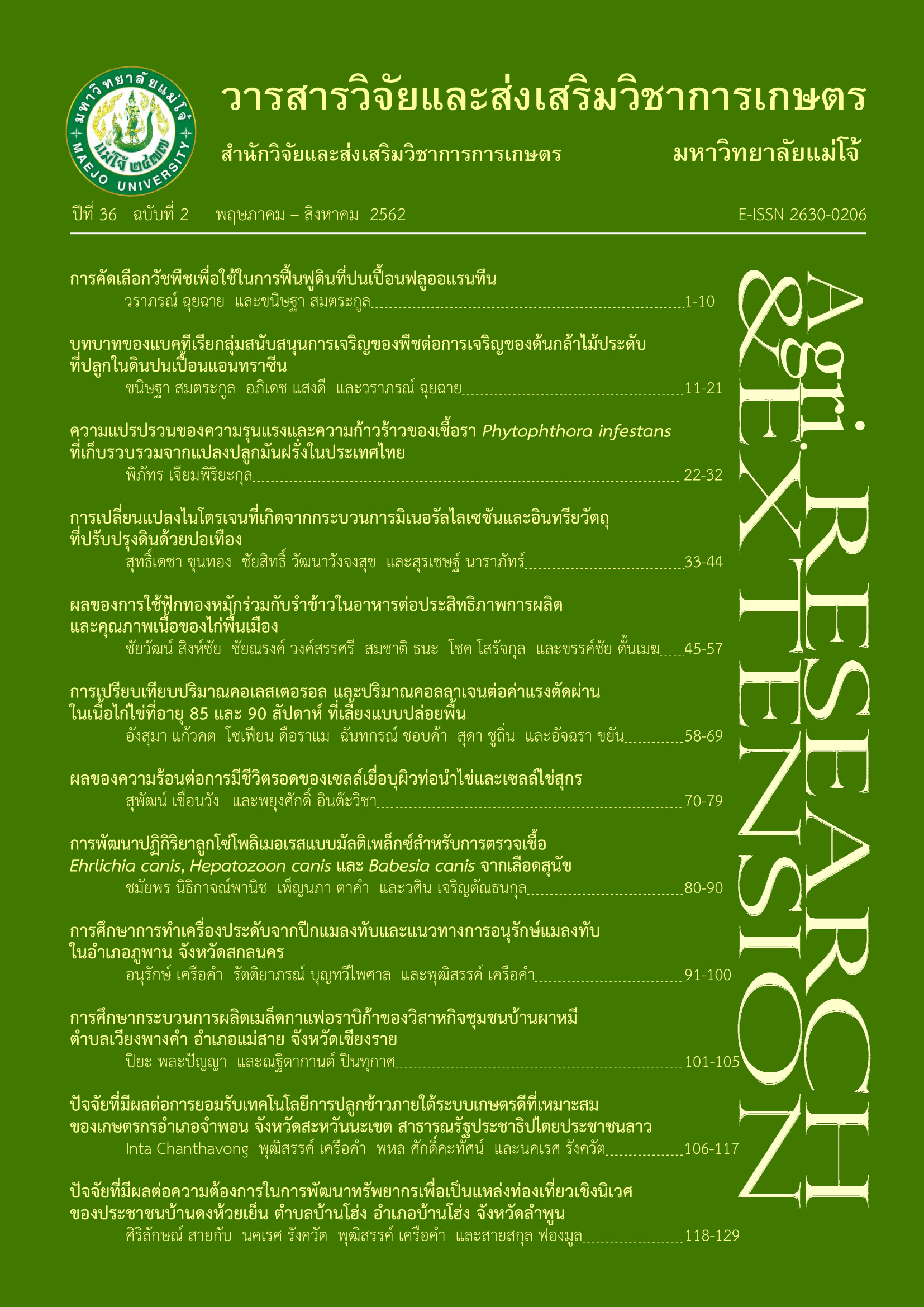การคัดเลือกวัชพืชเพื่อใช้ในการฟื้นฟูดินที่ปนเปื้อนฟลูออแรนทีน
คำสำคัญ:
การฟื้นฟูสภาพแวดล้อมด้วยพืช, โพลีไซคลิกอะโรมาติกไฮโดรคาร์บอน, วัชพืชบทคัดย่อ
การใช้พืชอาหารในการฟื้นฟูสภาพแวดล้อมด้วยพืชก่อให้เกิดความกังวลเกี่ยวกับการถ่ายทอดเข้าสู่ห่วงโซ่อาหารของสารมลพิษ ดังนั้นจึงศึกษาประสิทธิภาพของการใช้วัชพืชเพื่อบำบัดดินที่ปนเปื้อนฟลูออแรนทีน โดยนำวัชพืช 3 ชนิดคือ แห้วหมู ลูกใต้ใบ และบานไม่รู้โรยป่า มาปลูกในดินที่ปนเปื้อนฟลูออแรนทีน 200 มิลลิกรัมต่อกิโลกรัม เป็นเวลา 30 วัน เปรียบเทียบการเจริญเติบโตและปริมาณฟลูออแรนทีนที่ยังคงเหลืออยู่ในดิน โดยพบว่าฟลูออแรนทีนไม่เป็นพิษต่อการเจริญเติบโตของ ยอดวัชพืชทั้ง 3 ชนิด แต่ส่งผลต่อน้ำหนักของรากแห้วหมูและบานไม่รู้โรยป่า โดยทำให้น้ำหนักสดและน้ำหนักแห้งของรากพืชทั้งสองชนิดลดลง 58-67 และ 61% ตามลำดับเมื่อเปรียบเทียบกับต้นที่เจริญเติบโตในดินไม่ปนเปื้อน ฟลูออแรนทีน ไม่ส่งผลต่อปริมาณคลอโรฟิลล์ในใบแห้วหมู และบานไม่รู้โรยป่า แต่ทำให้คลอโรฟิลล์บีและคลอโรฟิลล์ทั้งหมดของลูกใต้ใบลดลง 34.8 และ 20.2% ตามลำดับเมื่อเปรียบเทียบกับต้นที่เจริญเติบโตในดินไม่ปนเปื้อน อย่างไรก็ตามมีเพียงแห้วหมูเท่านั้นที่สามารถลดปริมาณฟลูออแรนทีนในดินได้มากกว่าดินที่ไม่ปลูกพืชเมื่อเวลาผ่านไป 30 วัน โดยมีปริมาณฟลูออแรนทีนที่เหลืออยู่ร้อยละ 58.2 ในขณะที่ดินไม่ปลูกพืชเหลือฟลูออแรนทีนอยู่ ร้อยละ 62.6 แต่ไม่แตกต่างกันอย่างมีนัยสำคัญทางสถิติ ฟลูออแรนทีนเป็นพิษต่อปริมาณคลอโรฟิลล์ของลูกใต้ใบ และมีผลกระทบต่อน้ำหนักสดและน้ำหนักแห้งของแห้วหมูและบานไม่รู้โรยป่า จึงควรคัดเลือกวัชพืชทนทานต่อความเป็นพิษของฟลูออแรนทีนได้ดีกว่าพืชทั้งสามชนิดนี้
เอกสารอ้างอิง
Chouychai, W., A. Tongkukiatkul, S. Upatham, H. Lee, P. Pokethitiyook and M. Kruatrachue. 2009. Plant-enhanced phenanthrene and pyrene biodegradation in acidic soil. J. Environ. Biol. 30: 139-144.
Chouychai, W. 2011. Distribution and phytotoxicity of polycyclic aromatic hydrocarbons. RMUTP Research J. 5(1): 140-152. [in Thai]
Gadde, B., S. Bonnet, C. Menke and S. Garivait. 2009. Air pollutant emissions from rice straw open field burning in India, Thailand, and the Philippines. Environ. Pollut. 157: 1554-1558.
Huang, X.D., Y. El Alawi, D.M. Penrose, B.R. Glick and B.M. Greenberg. 2004. Response of three grass species to creosote during phytoremediation. Environ. Pollut. 130: 453-463.
Hultgren, J., L. Pizzul, M.P. Castillo, and U. Granhall. 2010. Degradation of PAH in a creosote-contaminated soil. A comparison between the effects of willows (Salix viminalis), wheat straw and a nonionic surfactant. Int. J. Phytoremediat. 12: 54-66.
Ikeura, H., Y. Kawasaki, E. Kaimi, J. Nishiwaki, K. Noborio and M. Tamaki. 2016. Screening of plants for phytoremediation of oil-contaminated soil. Int. J. Phytoremediat. 18: 460-466.
Liste, H. and M. Alexander. 2000. Plant-promoted pyrene degradation in soil. Chemosphere 40: 7-10.
Liste, H. and I. Prutz. 2006. Plant performance, dioxygenase-expressing rhizosphere bacteria, and biodegradation of weathered hydrocarbons in contaminated soil. Chemosphere 62: 1411-1420.
Nadal, M., M. Schuhmacher and J.L. Domingo. 2004. Levels of PAHs in soil and vegetation samples from Tarragona County, Spain. Environ. Pollut. 132: 1-11.
Oanh, N.T.K., L.B. Reutergardh, Tr. Dung, N. Yu, W.X. Yao and H.X. Co. 2000. Polycyclic aromatic hydrocarbons in the airborne particulate matter at a location 40 km north of Bangkok, Thailand. Atmospher. Environ. 34: 4557-4563.
Parrish, Z.D., M.K. Banks and A.P. Schwab. 2005. Effect of root death and decay on dissipation of polycyclic aromatic hydrocarbons in the rhizosphere of yellow sweet clover and tall fescue. J. Environ. Qual. 34: 207-216.
Rezek, J., C. Wiesche, M. Mackova, F. Zadrazil and T. Macek. 2008. The effect of ryegrass (Lolium perenne) on decrease of PAH content in long term contaminated soil. Chemosphere 70: 1603-1608.
Rezek, J., C. in der Wiesche, M. Mackova, F. Zadrazil and T. Macek. 2009. Biodegradation of PAHs in long-term contaminated soil cultivated with European white birch (Betula pendula) and red mulberry (Morus rubra) tree. Int. J. Phytoremediat. 11: 65-80.
Siciliano, S.D. and J.J. Germida. 1998. Mechanisms of Phytoremediation: biochemical and ecological interactions between plants and bacteria. Environ. Rev. 6: 65-79.
Somtrakoon, K., W. Wongsomsri, J. Wannarat and W. Chouychai. 2012. Phytoremediation of anthracene-contaminated soil by yard long bean and sweet corn. Sci. Technol. Ubonratchthanee University J. 14(4): 1-12. [in Thai]
Somtrakoon, K., W. Chouychai and H. Lee. 2014a. Comparing anthracene and fluorine degradation in anthracene and fluorene-contaminated soil by single and mixed plant cultivation. Int. J. Phytoremediat. 16: 415-428.
Somtrakoon, K., W. Chouychai and H. Lee.. 2014b. Phytoremediation of anthracene and fluoranthene-contaminated soil by Luffa acutangula. Maejo Inter. J. Sci. Technol. 8: 221-231.
Somtrakoon, K., W. Chouychai and H. Lee.. 2015. Removal of anthracene and fluoranthene by waxy corn, longbean and okra in lead-contaminated soil. Bull. Environ. Contam. Toxicol. 95: 407-413.
Sverdrup, L.E., P.H. Krogh, T. Nielsen, C. Kjaer and J. Stenessen. 2003. Toxicity of eight polycyclic aromatic hydrocarbons to red clover (Trifolium pretense) ryegrass (Lolium perenne) and mustard (Sinapsis alba). Chemosphere 53: 993-1003.
Tao, S., Y.H. Cui, F.L. Xu, B.G. Li, J. Cao, W.X. Liu, G. Schmitt, X.J. Wang, W.R. Shen, B.P. Qing and R. Sun. 2004. Polycyclic aromatic hydrocarbons (PAHs) in agricultural soil and vegetables from Tianjin. Sci. total Environ. 320: 11-24.
Wei, S. and S. Pan. 2010. Phytoremediation for soils contaminated by phenanthrene and pyrene with multiple plant species. J. Soil Sediments. 10: 886-894.
ดาวน์โหลด
เผยแพร่แล้ว
รูปแบบการอ้างอิง
ฉบับ
ประเภทบทความ
สัญญาอนุญาต

อนุญาตภายใต้เงื่อนไข Creative Commons Attribution-NonCommercial-NoDerivatives 4.0 International License.
บทความนี้ได้รับการเผยแพร่ภายใต้สัญญาอนุญาต Creative Commons Attribution-NonCommercial-NoDerivatives 4.0 International (CC BY-NC-ND 4.0) ซึ่งอนุญาตให้ผู้อื่นสามารถแชร์บทความได้โดยให้เครดิตผู้เขียนและห้ามนำไปใช้เพื่อการค้าหรือดัดแปลง หากต้องการใช้งานซ้ำในลักษณะอื่น ๆ หรือการเผยแพร่ซ้ำ จำเป็นต้องได้รับอนุญาตจากวารสาร





